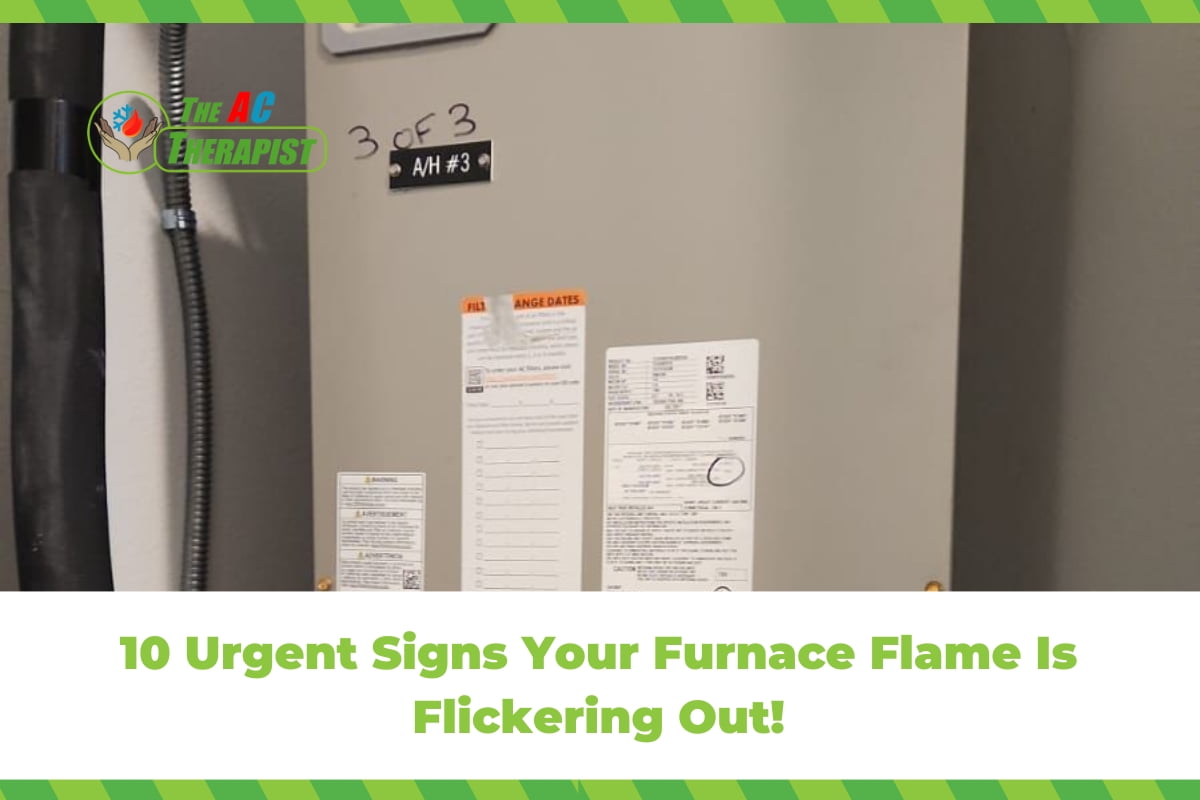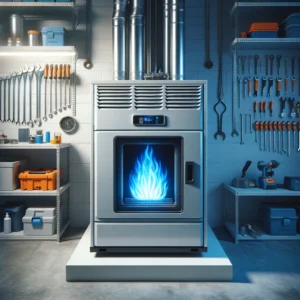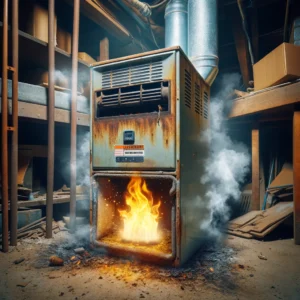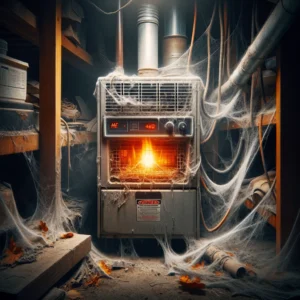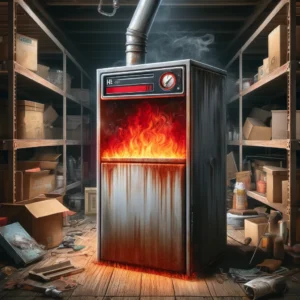10 Signs Your Furnace Flame Is Flickering Out!
Maintaining a comfortable and safe environment in your home heavily depends on the performance of your furnace, especially during times when you rely on it the most. The furnace is the powerhouse that drives warmth through your living spaces, creating a cozy refuge from the external environment. However, furnaces, like all mechanical systems, are prone to wear and tear over time. A flickering flame in your furnace is a subtle yet significant sign that there might be underlying issues threatening the efficiency and safety of your heating system.
Ignoring such a sign can lead to a range of problems, from inefficient heating and increased energy costs to potential safety hazards. Therefore, recognizing these warning signs and understanding their implications is critical. This blog aims to guide you through the top indicators that your furnace flame may be flickering out, what each sign could potentially mean, and why immediate attention is not just beneficial but necessary.
By exploring these warning signs, we aim to equip you with the knowledge to identify early symptoms of furnace problems. We’ll explain how these issues, if left unchecked, can impact the overall functionality and safety of your heating system. Staying informed and proactive about your furnace’s condition ensures it operates at peak efficiency, provides reliable warmth, and most importantly, maintains safety within your home. This approach not only extends the lifespan of your furnace but also helps in avoiding costly repairs or replacements in the future.
Understanding HVAC: Why Your Furnace Flame Flickering Out Matters
When it comes to maintaining a comfortable and efficient home environment, the health of your HVAC system is paramount. The furnace, a crucial component of this system, plays a vital role in heating your home effectively. However, one of the more subtle signs that your furnace may be experiencing issues is a flickering flame. Recognizing and understanding why your furnace flame is flickering is essential for ensuring the system operates safely and efficiently.
A flickering flame in a furnace typically indicates a potential malfunction within the heating system. This can be caused by a variety of issues ranging from minor concerns like a dirty burner to more severe problems like a malfunctioning gas valve or improper venting. Each of these can significantly impact the overall safety and performance of your heating system.
In this article, we delve deeper into the reasons behind a flickering furnace flame, examining how each can affect your HVAC system’s efficiency and safety. We’ll also provide insights on how to address these issues effectively, ensuring that your furnace continues to provide reliable warmth and operates at optimal safety levels.
1. Unusual Flame Color
One of the most evident signs that your furnace may be experiencing issues is an unusual color of the flame. Typically, a healthy furnace flame should burn a consistent blue color, with perhaps a small yellow tip at the point where the flame makes contact with the air. This blue color indicates that the gas is burning efficiently and completely, a process that produces primarily carbon dioxide and water vapor, which are relatively harmless in well-ventilated situations.
However, if the flame turns yellow, orange, or red, it suggests incomplete combustion, meaning the gas is not burning efficiently. This inefficiency can occur for several reasons, such as:
- Excess Carbon Monoxide: Incomplete combustion increases the production of carbon monoxide, a dangerous, odorless gas that poses serious health risks if inhaled.
- Dirty or Clogged Burner: Over time, burners can become clogged with dirt and debris, affecting the mixture of gas and air, which disrupts the combustion process.
- Inadequate Air Supply: A furnace requires a certain amount of air to burn gas properly. If the air supply is restricted, either due to a blockage in the intake paths or leaks in the duct system, the flame color may change as a result of the altered air-to-fuel ratio.
- Improper Gas Pressure: The gas pressure may also be set incorrectly, or there could be fluctuations in the gas supply. Either scenario can lead to a change in flame color due to improper combustion.
If you notice an unusual flame color, it is crucial to address this issue promptly. Continuing to operate your furnace under these conditions not only leads to higher energy consumption and costs but also significantly increases the risk of carbon monoxide poisoning. Regular maintenance checks, including cleaning the burners and ensuring proper air and gas flow, can help prevent these problems and maintain the efficiency and safety of your furnace.
2. Flickering or Wavering Flame
A stable, consistent flame is a hallmark of a well-functioning furnace. If the flame inside your furnace is flickering or wavering excessively, this could be indicative of several underlying issues that need immediate attention. While some slight movement in the flame is normal due to natural airflow in the environment, persistent flickering or significant wavering is not and suggests that the combustion process is unstable.
Several factors can contribute to a flickering or wavering furnace flame:
- Airflow Issues: One common cause of flame flickering is turbulent airflow within the furnace. This can be due to a dirty air filter restricting the flow of air, blocked vents, or even the incorrect installation of ductwork. Ensuring that your furnace’s air intake and outflow systems are clear and functioning correctly is crucial for maintaining a steady flame.
- Fluctuating Gas Pressure: Another factor could be inconsistent gas pressure. Variations in gas pressure affect the rate at which gas flows into the combustion chamber, leading to instability in the flame. This might be a result of issues with your gas supply line or the gas regulator needing adjustments.
- Component Wear and Tear: Over time, components of the furnace, such as the burner orifice or the heat exchanger, can wear out or become damaged. This wear can alter the conditions within the combustion chamber, affecting how the flame burns.
- Drafts: External drafts or the placement of the furnace near frequently used doors or windows can also lead to flickering flames. Changes in external air pressure can disrupt the balance needed for a steady flame inside the furnace.
If you observe a flickering or wavering flame, it is advisable to conduct a thorough check or have a professional HVAC technician inspect the system. They can assess the air and gas flow, check for worn-out parts, and make the necessary adjustments to stabilize the flame. Regular maintenance and timely repairs can prevent this issue from developing into more serious problems, ensuring your furnace operates safely and efficiently.
3. Soot Buildup
Soot buildup in a furnace is a problematic sign that indicates incomplete combustion, which is when fuel does not burn cleanly or completely. The presence of soot is not only a sign of inefficiency but also a potential hazard, as it can lead to poorer air quality and increased fire risk.
Causes of Soot Buildup:
- Improper Air-to-Fuel Ratio: A correct balance of air and fuel is crucial for complete combustion. If there is too much fuel and not enough air, it leads to incomplete combustion and the subsequent production of soot.
- Clogged Burners: Dirty or clogged burners can impede the flow of air necessary for the fuel to burn efficiently. This results in a cooler flame that does not completely oxidize the carbon particles, leading to soot formation.
- Aged or Faulty Equipment: As the furnace ages, its components can wear out and function less efficiently. For example, a failing heat exchanger can reduce the combustion temperature, preventing complete burning of the fuel.
Implications of Soot Buildup:
- Decreased Efficiency: Soot acts as an insulator on heat exchange surfaces. This insulation effect reduces the furnace’s ability to transfer heat to the air in your home, requiring more fuel to maintain the same level of warmth, thereby decreasing efficiency and increasing heating costs.
- Health Respect: Soot particles can become airborne and degrade indoor air quality. Breathing in these particles can pose health risks, particularly affecting the respiratory system.
- Potential Fire Hazard: Accumulated soot can catch fire if temperatures in the furnace get high enough, posing a serious fire hazard.
Addressing Soot Buildup:
- Regular Maintenance: Schedule regular maintenance checks to ensure that the furnace is clean and all components are in good working order. This includes cleaning or replacing air filters and inspecting the burners and heat exchangers for signs of soot or damage.
- Adjust the Burner: An HVAC technician can adjust the burners and air intakes to ensure the proper air-to-fuel ratio for optimal combustion.
- Inspect Ventilation: Ensure that the furnace’s ventilation system is not blocked or leaking. Proper venting is essential for carrying away combustion gases and supporting complete combustion.
- Upgrade Old Equipment: If soot buildup is a recurring problem, it may be time to consider replacing your old furnace with a newer, more efficient model that burns cleaner and is less prone to soot formation.
Prompt attention to soot buildup not only improves the efficiency and longevity of your furnace but also ensures that your home remains safe and comfortable. Regular inspections and maintenance are key to preventing soot and ensuring that your furnace operates at peak performance.
4. Odd Sounds
Unusual noises coming from your furnace are not just a nuisance; they often signify underlying issues that need immediate attention. These sounds can vary widely—from banging and popping to whistling and grinding—and each type of noise may indicate a different type of problem. Identifying and addressing these sounds promptly can help prevent more severe damage to your furnace and ensure it operates safely and efficiently.
Common Types of Furnace Noises and Their Potential Causes:
- Banging or Popping: These sounds are often caused by the ductwork expanding and contracting as the furnace cycles on and off. However, if the noise is coming directly from the furnace, it could indicate delayed ignition due to a buildup of gas or a dirty burner. This is a serious issue as it can be dangerous and should be addressed by a professional.
- Whistling: A whistling noise usually suggests an issue with airflow. This could be due to a clogged air filter, closed or obstructed vents, or gaps in the ductwork. Ensuring that the air can flow freely through the system is essential for proper operation.
- Scraping or Grinding: These sounds typically indicate a problem with the furnace’s blower wheel. If the wheel becomes loose, or if it’s broken, it can scrape against the housing. Bearings in the motor can also wear out, causing a grinding noise. Both scenarios are indicative of a need for immediate repair to prevent further damage to the engine and other components.
- Rattling: Rattling noises can be caused by loose panels on the furnace itself or by smaller components within the furnace that have loosened over time. Tightening these parts or adding insulation around them can often resolve the issue.
Steps to Address Odd Sounds from Your Furnace:
- Inspect and Replace the Air Filter: Regularly check and replace the air filter if it is dirty. A clean filter ensures optimal airflow and can prevent many noise issues related to air pressure and flow.
- Check Ductwork and Vents: Ensure all vents are open and unobstructed, and inspect the ductwork for any leaks, gaps, or bends that might cause noise issues. Proper duct sealing and insulation can reduce noise and improve efficiency.
- Secure Loose Components: Inspect your furnace for any loose parts or panels. Tightening these can often eliminate rattling noises.
- Schedule Professional Maintenance: If you’re unable to determine the cause of the noise or if the noise indicates a serious issue, it’s best to call a professional HVAC technician. They can perform a comprehensive check, identify the source of the noise, and make the necessary repairs.
Understanding and responding to unusual furnace noises not only helps extend the life of your furnace but also ensures it runs safely and efficiently. Regular maintenance and timely repairs are key to keeping your furnace in good working order and preventing unexpected breakdowns during periods when you rely on it the most.
5. Frequent Cycling
If your furnace turns on and off more frequently than usual, this could be a sign of an overworked system. Frequent cycling can be caused by a faulty thermostat, improper furnace size for your home, or a clogged filter. This not only leads to inefficiencies but can also put undue stress on your furnace, leading to other problems like a flickering flame.
6. An Increase in Heating Bills
An unexpected increase in your heating bills can indicate that your furnace is losing efficiency. When the flame does not burn properly, the furnace has to work harder and run longer to produce the same amount of heat, thus consuming more fuel and increasing your bills.
7. Carbon Monoxide Detector Goes Off
If your carbon monoxide detector goes off, it is a serious indication that your furnace could be producing this lethal gas, often due to improper combustion. If the alarm sounds, ensure to ventilate the area and call a professional immediately.
8. The Age of Your Furnace
The age of your furnace can be a crucial factor in its performance. Most furnaces have a lifespan of about 15-20 years. If yours is approaching or has surpassed this age range and you start noticing a flickering flame, it might be time to consider a replacement.
9. Water Pooling Around the Furnace
Water pooling around the furnace is not a direct cause of flame flickering but can indicate other issues like a clogged condensate drain or a leaking humidifier that can indirectly affect the furnace’s operation.
10. Thermostat Issues
Sometimes the problem isn’t with the furnace itself but with the thermostat. If the thermostat is malfunctioning, it may not be communicating correctly with the stove, leading to irregular heating and possibly a flickering flame.
What to Do Next
If you notice any of these warning signs, it’s crucial to act swiftly:
- Regular Maintenance: Annual or semi-annual maintenance by a certified technician can prevent most of the issues that cause a flickering flame.
- Check and Replace Your Air Filter: A dirty air filter restricts airflow and can cause numerous furnace issues. Check your filter monthly and replace it as needed.
- Professional Inspection and Repair: If the problem persists, it’s time to call in the professionals. A certified HVAC technician can diagnose and repair your furnace safely and efficiently.
Ignoring the signs of a failing furnace flame can be dangerous. It’s always better to address these issues early to ensure your home remains safe, warm, and energy-efficient. Remember, your furnace is not just another appliance but a vital part of your home’s comfort and safety. Treat it with care, and it will continue to serve you well through the cold months.
Furnace Troubles? Don’t Miss These Critical Warning Signs!
As The AC Therapist, I understand how crucial a reliable furnace is to your home’s comfort and safety. Recognizing the early warning signs of a flickering flame can save you from costly repairs and ensure your furnace operates efficiently and safely. Whether it’s an unusual flame color, a flickering or wavering flame, soot buildup, or strange noises, each symptom is a call to action.
Don’t wait until these issues escalate into major problems. Regular maintenance and timely intervention are your best defense against furnace failures. If you notice any of these warning signs, reach out to us. At The AC Therapist, we’re dedicated to ensuring your heating system is in top condition, providing the peace of mind you deserve in your home. Remember, a little awareness and care can go a long way in maintaining the warmth and safety of your living space.

